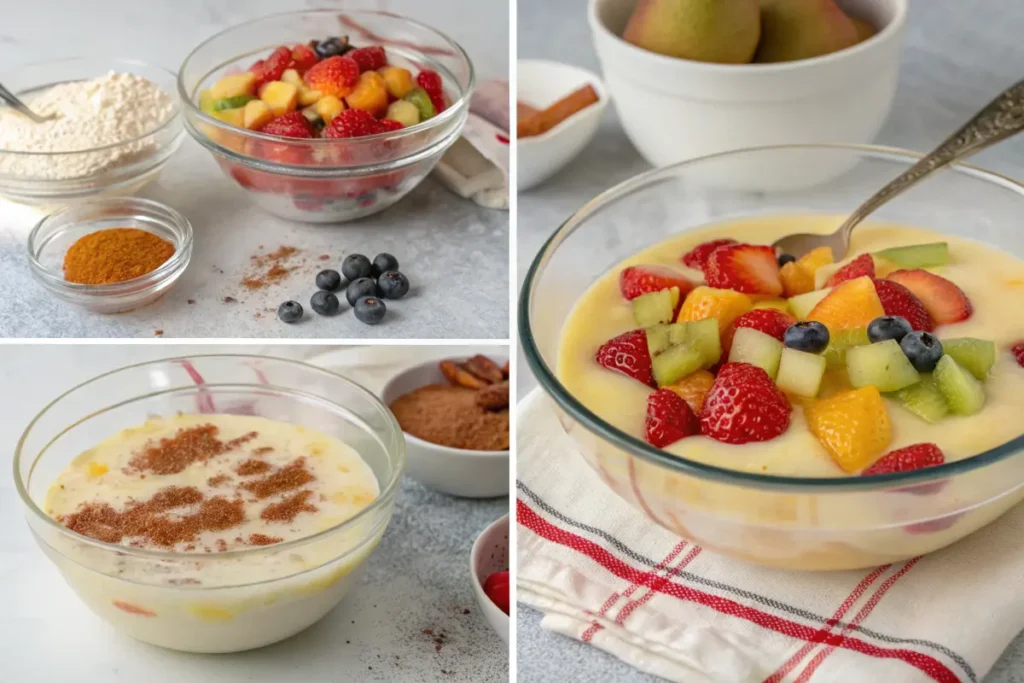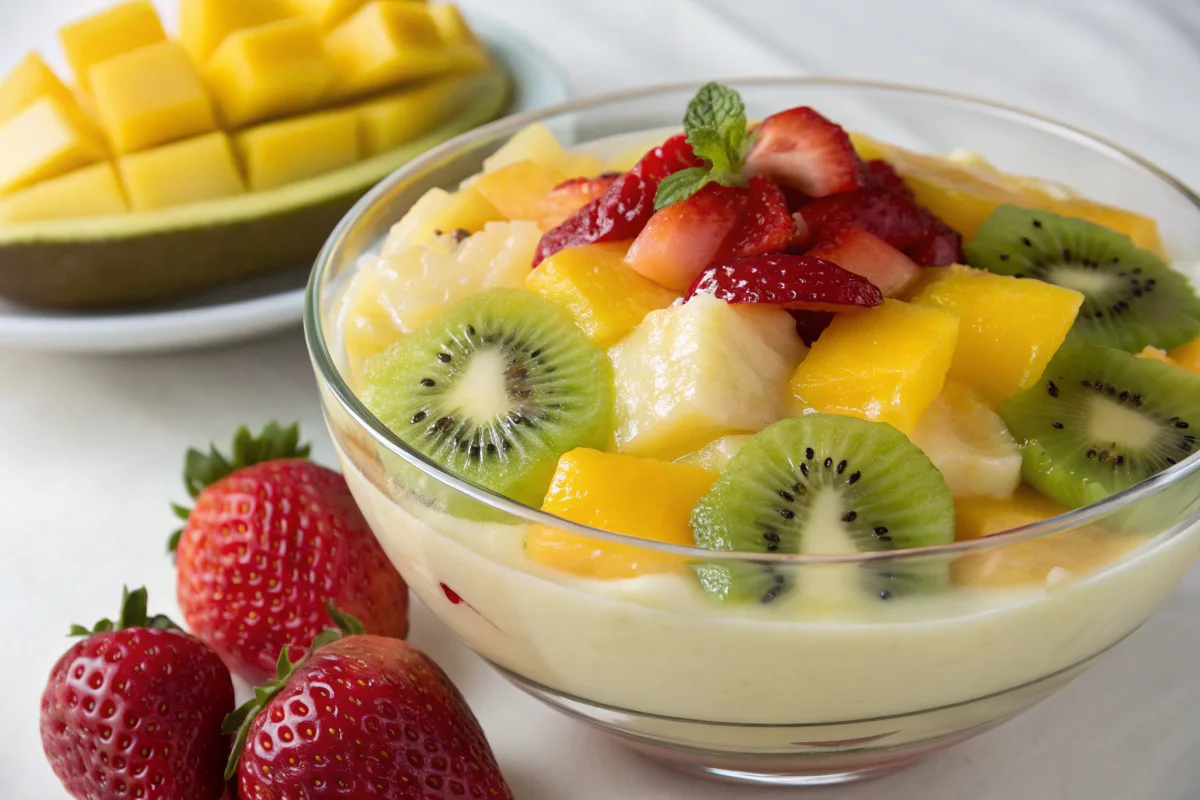Nata Fruit Pudding: A Delicious and Refreshing Dessert
Introduction
If you’ve never tried Nata Fruit Pudding, you’re in for a treat! This refreshing and creamy dessert has been winning hearts around the globe, thanks to its light texture and delicious fruity flavor. Whether you’re looking for a healthy alternative to heavy desserts or simply craving something sweet, Nata Fruit Pudding has you covered. In this article, we’ll explore everything you need to know about this tropical dessert – from what it is and how to make it, to its nutritional benefits and worldwide variations. So, let’s dive in!
What is Nata Fruit Pudding?
Understanding Nata Fruit Pudding
At its core, Nata Fruit Pudding is a sweet, refreshing dessert made from nata de coco (a chewy, translucent coconut-based jelly) combined with fresh, juicy fruits. This delightful treat is not only visually appealing but also offers a unique texture, with the smoothness of pudding and the chewy bite of nata de coco. It’s often served chilled, making it perfect for warm weather.
Nata de coco itself is made by fermenting coconut water into a gelatinous form, which is why it has a subtle coconut flavor and a slightly chewy texture. This pudding is popular in many tropical countries, where fresh fruits like mango, pineapple, and papaya are abundant. It’s versatile, allowing you to tailor it to your taste preferences by mixing in different fruits or even adding a drizzle of sweet syrup for extra flavor.
Key Ingredients in Nata Fruit Pudding
The key to a fantastic Nata Fruit Pudding lies in its simple yet vibrant ingredients. Below is a table with the ingredients listed in U.S. measurements:
| Ingredient | Quantity |
|---|---|
| Nata de Coco | 7 oz (approximately 1 cup) |
| Fresh Fruits | 10.5 oz (e.g., mango, pineapple, kiwi) |
| Sweetener (condensed milk, sugar syrup, honey) | 2 to 3 tbsp |
| Coconut Milk or Cream | 3.5 fl oz (about 1/2 cup) |
When these ingredients come together, they create a pudding that’s not only delicious but also bursting with tropical flavors. Whether served as a light snack or a sweet finish to a meal, Nata Fruit Pudding is a treat you won’t soon forget.
How to Make Nata Fruit Pudding

Step-by-Step Recipe for Nata Fruit Pudding
Making Nata Fruit Pudding is surprisingly simple and doesn’t require any complicated ingredients. Here’s a basic recipe to get you started:
- Prepare the Nata de Coco:
If you’re using store-bought nata de coco, drain the liquid and cut it into small cubes or bite-sized pieces. If you want a more homemade touch, you can make it from scratch, but for this recipe, store-bought works perfectly! - Chop the Fresh Fruits:
Choose a variety of fresh fruits you like. Common choices include mango, pineapple, kiwi, and strawberries. Chop them into small pieces that will mix well with the nata de coco. - Mix the Ingredients:
In a large bowl, combine the chopped fruits and nata de coco. If you like a more flavorful pudding, this is the time to add some sweetener like condensed milk, honey, or sugar syrup. Stir the mixture gently to ensure the fruits and nata de coco are evenly distributed. - Add Coconut Milk or Cream:
Pour in the coconut milk or cream to create a smooth and creamy base. Stir it in well until everything is combined. Adjust the amount of coconut milk depending on how creamy you want your pudding to be. - Chill and Serve:
Transfer the mixture to individual bowls or a large serving dish. Cover it and refrigerate for at least 2-3 hours to allow the flavors to blend together. Serve chilled, and garnish with additional fruits if desired.
Tips for Perfecting Nata Fruit Pudding
To make sure your Nata Fruit Pudding turns out perfectly, keep these tips in mind:
- Balance the sweetness: You can adjust the sweetness of the pudding by adding more or less sweetener. Some prefer it lightly sweetened, while others enjoy it richer and sweeter.
- Choose ripe fruits: The key to great flavor in this pudding lies in using fresh, ripe fruits. Opt for fruits that are in season to get the best taste and texture.
- Don’t skip the chilling step: The longer you chill the pudding, the better the flavors will blend. It also helps the nata de coco to firm up a bit, giving the pudding its signature texture.
- Experiment with flavors: Feel free to get creative by adding your favorite fruits or even a splash of fruit juice to the mix. Adding a few drops of vanilla extract can also give it an extra layer of flavor.
Nutritional Benefits of Nata Fruit Pudding
Health Benefits of Nata Fruit
One of the main advantages of Nata Fruit Pudding is its healthful ingredients. Nata de coco, the coconut-based jelly, is low in calories and provides a small amount of fiber, which can aid in digestion. Additionally, it’s a great alternative to heavier desserts like cakes or ice cream, making it a light option for those watching their calorie intake.
The fruits you use in the pudding, such as mango, pineapple, and kiwi, are packed with essential vitamins, antioxidants, and fiber. For example, mangoes are rich in Vitamin C, which supports immune health, while kiwis offer a good dose of Vitamin K and fiber. Pineapples, on the other hand, contain bromelain, an enzyme known to aid digestion and reduce inflammation.
Why Nata Fruit Pudding Makes a Healthy Dessert Choice
Aside from being delicious, Nata Fruit Pudding is also a healthier alternative to many traditional sugary desserts. Here’s why:
- Low in calories: With its light, fruity base, it provides sweetness without the heavy sugar load found in many other desserts.
- Packed with nutrients: Fresh fruits bring in essential vitamins and minerals, while nata de coco offers a chewy texture with minimal fat.
- Customizable for dietary needs: If you’re vegan or dairy-free, you can easily make Nata Fruit Pudding with coconut milk and a plant-based sweetener, making it suitable for various diets.
Variations of Nata Fruit Pudding

Different Fruit Combinations for Nata Fruit Pudding
One of the best things about Nata Fruit Pudding is its versatility. While traditional recipes call for tropical fruits like mango, pineapple, and kiwi, there’s no limit to the types of fruits you can use. Depending on what’s in season or your personal taste preferences, feel free to experiment with different combinations.
For example, you could try pairing the smoothness of mango with the tartness of passion fruit for a tropical twist. Alternatively, berries like strawberries, blueberries, or raspberries add a vibrant pop of color and a bit of tang to balance the sweetness of the pudding. If you’re looking for something even more exotic, consider using dragon fruit or lychee for a unique touch.
The beauty of Nata Fruit Pudding lies in its adaptability. Want to make it extra refreshing? Add some chilled cucumber or melon slices for an added burst of coolness. The possibilities are endless, so don’t be afraid to mix and match until you find your perfect fruit combination!
Vegan and Dairy-Free Options for Nata Fruit Pudding
If you’re following a vegan or dairy-free lifestyle, don’t worry – Nata Fruit Pudding can easily be made to fit your dietary preferences. For a creamy base, simply substitute coconut milk or almond milk for regular dairy. These plant-based options provide the same creamy texture without the need for any animal products.
Additionally, you can replace traditional sweeteners with plant-based options like maple syrup or agave nectar. Just make sure to adjust the sweetness according to your taste. By making these simple swaps, you’ll end up with a dessert that’s both dairy-free and delicious – perfect for those with dietary restrictions or anyone looking for a healthier alternative. If you’re interested in exploring other dairy-free desserts, check out this Pistachio Pudding with Grapes recipe.
Nata Fruit Pudding Around the World
How Nata Fruit Pudding is Enjoyed Globally
Nata Fruit Pudding is a beloved dessert that has gained popularity worldwide, particularly in tropical regions where fresh fruits and coconut are abundant. In places like the Philippines and Indonesia, nata de coco is commonly used in a variety of desserts, often combined with other sweet treats like sago pearls or jackfruit.
While Nata Fruit Pudding might be less common in Western countries, it’s gradually becoming more popular as people discover the joys of this light and refreshing treat. In many tropical nations, it’s often served at family gatherings, celebrations, or simply as a refreshing snack on a hot day. Whether enjoyed as a quick dessert or part of a larger festive spread, Nata Fruit Pudding is sure to be a hit wherever it’s served.
Cultural Significance of Nata Fruit Pudding
In many countries where Nata Fruit Pudding is popular, it holds cultural significance. The use of coconut in desserts has long been a part of Southeast Asian food traditions, and nata de coco adds a unique twist to this well-loved ingredient. The pudding’s light texture and fruity flavor are perfect for reflecting the laid-back, tropical lifestyle of the regions where it originated.
Moreover, as a dessert, Nata Fruit Pudding is often seen as a symbol of hospitality and sharing. It’s a dish that brings people together, whether at casual family meals or special occasions. So, when you make or enjoy Nata Fruit Pudding, you’re not just indulging in a sweet treat – you’re partaking in a tradition of warmth, togetherness, and celebration.
FAQs About Nata Fruit Puddin
What is the best fruit to use for Nata Fruit Pudding?
When it comes to choosing the best fruits for Nata Fruit Pudding, it all comes down to personal preference. However, tropical fruits are a popular choice due to their sweet and juicy flavor. Fruits like mango, pineapple, and kiwi are ideal because they blend well with the creamy texture of the coconut milk and the chewy nata de coco.
If you’re looking for a bit of tang, strawberries or passion fruit can add a delightful contrast to the sweetness. In fact, many people enjoy mixing a variety of fruits to get the perfect balance of flavors. Ultimately, the best fruit is the one you love most!
Can Nata Fruit Pudding be made in advance?
Absolutely! One of the best things about Nata Fruit Pudding is that it can be made ahead of time. In fact, chilling the pudding for a few hours or overnight helps the flavors to meld together, resulting in a more delicious and refreshing dessert. Simply prepare the pudding, cover it, and store it in the fridge until you’re ready to serve.
Not only does making it in advance save you time, but it also enhances the texture as the nata de coco firms up a bit, making it even more enjoyable. Whether you’re prepping for a party or just want a tasty treat on hand, Nata Fruit Pudding is a fantastic make-ahead dessert.
What is the texture of Nata Fruit Pudding?
The texture of Nata Fruit Pudding is one of its defining characteristics. The creamy base, made from coconut milk or cream, is smooth and luscious, while the nata de coco adds a slight chewiness. This combination creates a delightful contrast that makes each bite exciting. The fruit chunks further enhance the pudding with their soft, juicy texture.
When served chilled, Nata Fruit Pudding feels refreshing and light in your mouth, making it a perfect treat for warmer weather.
Common Mistakes to Avoid When Making Nata Fruit Pudding
How to Avoid Watery Nata Fruit Pudding
One of the most common mistakes when making Nata Fruit Pudding is ending up with a watery consistency. This can happen if you add too much coconut milk or use overly juicy fruits. To avoid this, be sure to use the right amount of coconut milk – about 1/2 cup (or 3.5 fl oz) is perfect for a creamy pudding without it becoming too runny.
Also, when using fruits, opt for those that aren’t too watery, or be sure to drain them thoroughly before mixing them into the pudding. For example, while kiwi is a great choice, watermelon might release too much liquid and make your pudding soggy.
Tips for Ensuring a Smooth Consistency
Another potential issue is ending up with a lumpy or uneven texture. To prevent this, make sure to mix your ingredients gently but thoroughly. If you’re adding sweeteners, dissolve them fully before incorporating them into the pudding. This ensures a smoother consistency and a more even sweetness throughout.
Additionally, giving the pudding plenty of time to chill in the refrigerator will allow it to set properly, resulting in the ideal creamy and chewy texture. So, be patient and let the flavors meld before serving for the best result!


